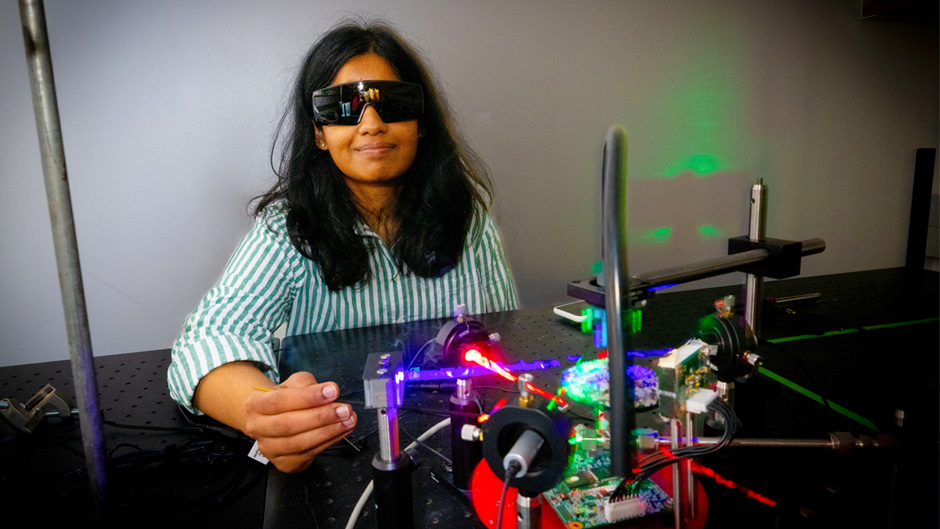Shruti Choudhary wants to help feed the world. To do so, she doesn’t intend to organize a telethon or create a global food assistance program.
Instead, the University of Miami researcher will turn to the hi-tech field of nanotechnology, putting it into the hands of farmers who will wield its power to increase crop yields and, in turn, feed a global population that is projected to reach 9.7 billion people by the year 2050.
“Where will we find enough food to feed the multitudes?” asked Choudhary, a Ph.D. student in aerosol science at the College of Engineering. “It would be much easier to feed so many if we were able to grow crops more efficiently and without damaging the environment and depleting our precious water supplies. That’s the challenge farmers face.”
Through her early-stage agriculture tech startup, Smart Aerosol Technologies or SmArT, Choudhary is helping farmers overcome that challenge, synthesizing zinc nanoparticles in the college’s Aerosol and Air Quality Research Laboratory, with the goal of applying the tiny units—some smaller than the width of a human hair—to crops to increase their growth and yield.
“We call it nanofertilizer, and it’s the next generation of plant food but without the drawbacks,” Choudhary said of the technique she is helping to perfect.
Plants, she noted, can absorb only so much of the nutrients in conventional fertilizer, which is typically applied through soil or by mixing it with water. A significant amount of two key nutrients in fertilizer that plants need to grow and develop—nitrogen and phosphorous—gets trapped in the soil and eventually washed away by rains, ending up in lakes, rivers, and other water systems where they can cause harmful algal blooms.
In contrast, the particles in SmArT’s nanofertilizers are so small and well engineered they would be absorbed by crops more efficiently when applied to their leaves rather than the soil, reducing farmers’ dependency on conventional fertilizers and lessening the impact on ecosystems, Choudhary said.
The process has already been field tested with promising results. In a previous study, College of Engineering dean and renowned aerosol scientist Pratim Biswas, Choudhary’s mentor, used zinc nanoparticles to increase the growth and yield of mung beans, a nutritional powerhouse high in protein, fiber, and other minerals and grown extensively in Asia. “We were able to increase the activity of three important enzymes within the plants: acid phosphatase, alkaline phosphatase, and phytase,” Biswas said. “These enzymes react with complex phosphorus compounds in soil, converting them into forms that plants can take up easily.”
It was Biswas, collaborating with nanoparticle technology expert Ramesh Raliya, who founded SmArT before he arrived at the University of Miami, developing the technique to create its nanofertilizer, then field testing it not only on mung beans but also on corn and soybean crops on farms in Illinois. “The farmers saw immediate results compared to the conventional fertilizer they were using,” Biswas said.
Now, Choudhary leads the startup. SmArT’s nanofertilizers, she said, also have the potential to ramp up the nutritional value of crops. She noted a previous study by Biswas that found that the amount of the powerful antioxidant lycopene in tomatoes increased by as much as 113 percent when zinc oxide nanoparticles were applied to tomato plants.
With a $125,000 investment for winning eMerge Americas’ recent Startup Showcase, as well as a $100,000 grant from last year’s University Startup Accelerator, or USTAAR, she plans to apply nanofertilizers to certain field- and greenhouse-based crops in Florida, with testing tentatively scheduled for some time in August.
Choudhary’s nanofertilizer research has worldwide implications, with the potential to benefit farmers in resource-strained areas that suffer from prolonged droughts.
Her paternal grandfather is a farmer in India’s western state of Rajasthan, which frequently experiences drought conditions. “As a little girl, I would visit his farm during the summer and take morning walks in the fields,” she recalled. “Many of the crops had already been cultivated, but I was aware of the difficulties he and other farmers often faced because of water scarcity issues. Nanofertilizers could help protect what little precious water supplies regions like Rajasthan have.”
Nanofertilizer is but one aspect of Choudhary’s extensive research portfolio. She has also studied the airborne transmission of COVID-19 in different health care settings such as dental offices, intensive care units, and emergency departments; and she documented the levels of aerosol emissions firefighters are exposed to during fire training exercises, controlled burns, and electric vehicle fires.
She is developing a next-generation sensor that would not only identify the quantity of particulate matter in the air but also the type and composition. Initial tests have proved successful, with the sensor able to distinguish between particles from Arizona dust, lunar regolith, smoke, and sodium chloride.
“Her work with sensors is path-breaking and will greatly benefit firefighters and other first responders, keeping them safe while they save the lives of others,” Biswas said.

